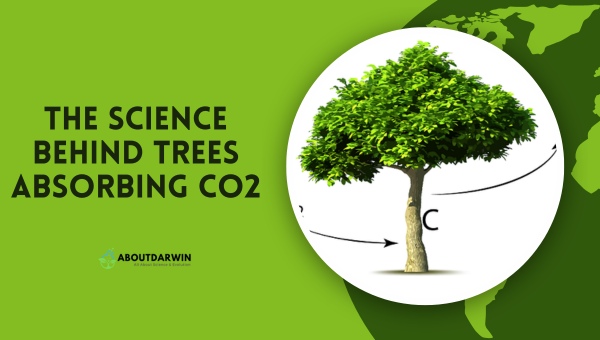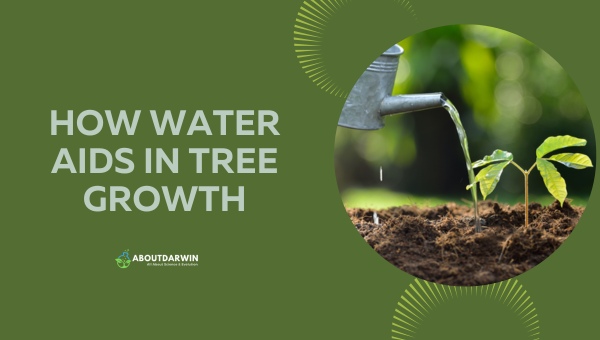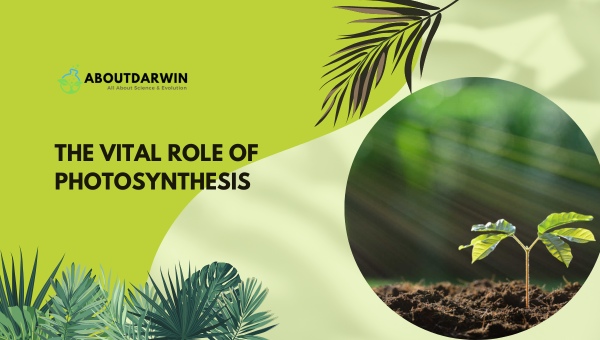Physical Address
304 North Cardinal St.
Dorchester Center, MA 02124
You might find it surprising that trees can grow and flourish using carbon dioxide and water. This process, known as photosynthesis, allows trees and other green plants to utilize energy from sunlight, transforming simple inorganic substances into organic matter. Understanding how tree growth is fascinating and crucial to understanding the delicate balance of Earth’s ecosystems.
Plants and trees rely on a symbiotic relationship with our atmosphere. They take in carbon dioxide, which is released into the atmosphere by various natural processes and human activities. By absorbing this carbon dioxide and water, they convert these substances into glucose and oxygen, making trees essential in regulating the Earth’s climate.
So, the next time you walk by a tree or a forest, take a moment to appreciate the incredible, complex work happening beneath the surface. It’s through this natural process of photosynthesis that trees and other plants can grow and provide a vital service in maintaining the balance of our planet’s atmosphere.
Contents
Trees are crucial in mitigating climate change by capturing and storing carbon dioxide (CO2) from the atmosphere. Understanding how they do this is essential to appreciate the significance of nurturing and protecting our forests.

Trees primarily absorb CO2 during a process called photosynthesis. This is how it works:
The chemical equation for photosynthesis is:6 CO2 + 6 H2O + light energy -> C6H12O6 + 6 O2
Through photosynthesis, a single tree can absorb an estimated 48 pounds of CO2 annually. As trees mature, their capacity to store carbon increases significantly. As a result, older, larger trees often hold more carbon than those younger in age. The table below shows the typical amount of carbon stored in trees, depending on age and size:
| Tree Age (years) | Carbon Stored (pounds) |
|---|---|
| 1 – 10 | 1 – 20 |
| 10 – 20 | 20 – 100 |
| 20 – 50 | 100 – 1,000 |
| 50+ | 1,000 – 3,000 |
It’s important to note that tree species have varying capacities to absorb and store carbon. Here are some factors that influence a tree’s ability to store CO2:
Here are a few examples of tree species with varying capacities to store carbon:
In addition to photosynthesis, trees also release CO2 back into the atmosphere through respiration. Trees break down glucose during respiration to release energy, producing CO2 as a byproduct. This process is essential for their survival and normal functioning.
Despite this release of CO2, trees still act as net carbon sinks, absorbing more CO2 than they emit through the process of photosynthesis. This makes them vital partners in the battle against climate change.
Discover 4 Steps of the Nitrogen Cycle: Importance, Impact
Water plays a crucial role in the growth and health of trees. In this section, I’ll dive into the various ways that water aids in tree growth and development.

One major function of water in trees is to facilitate the process of photosynthesis. Trees convert sunlight, carbon dioxide, and water into glucose and oxygen during this process. This glucose serves as the primary energy source for the tree, helping it grow and develop. Additionally, the oxygen produced is released into the atmosphere, a benefit for all living organisms.
Moreover, water is essential for moving nutrients from the soil to various parts of the tree. When a tree absorbs water through its roots, it also takes in vital nutrients such as nitrogen, phosphorus, and potassium.
These nutrients are then transported from the roots to other areas of the tree through transpiration. Without adequate water, trees cannot deliver important nutrients to their branches, leaves, and other areas, hindering their growth.
Next, let’s look at how water impacts a tree’s physical structure. As trees grow, they continuously undergo the process of cell division and expansion. Water is vital to this process, as it helps moisten and soften a tree’s cell walls, allowing them to stretch and expand.
When trees take in water, their cells swell up, pushing the surrounding cells outward, causing the tree to grow both in height and width. Without water, tree growth would be limited in this regard.
Lastly, maintaining the right water balance is necessary for proper weight distribution within a tree. A healthy tree has a certain ratio of water within its layers, from the roots to the branch tips. This balance helps the tree maintain stability while bearing the weight of its branches, leaves, and possible fruit or seed production.
To sum up, water is instrumental in the following:
Trees rely heavily on water to grow and thrive, making it an integral part of their biology and overall health. Due to its importance, proper irrigation and tree care techniques are key to ensuring a tree’s successful growth and well-being.
Photosynthesis is crucial in how trees grow from carbon dioxide and water. It’s the process through which trees and other plants convert light energy, carbon dioxide (CO₂), and water (H₂O) into oxygen (O₂) and glucose (C₆H₁₂O₆), the energy source required for growth. In this section, I’ll shed light on the fascinating world of photosynthesis and its significance in tree growth.

Sunlight is the primary energy source for photosynthesis. Trees capture this energy using chlorophyll, a green pigment found in their leaves. The chlorophyll absorbs the sun’s light, which is then used to fuel a series of chemical reactions in tree cells. This is where carbon dioxide and water come into play.
With the energy provided by sunlight, trees use specialized cells called stomata to take in carbon dioxide from the atmosphere. Simultaneously, they absorb water from their roots. These raw materials inside the tree’s cells are converted into glucose through complex chemical reactions. As a byproduct, oxygen is produced and released back into the environment.
The overall photosynthesis process can be summarized in the following simple equation:
6CO₂ + 6H₂O + Light Energy → C₆H₁₂O₆ + 6O₂
Glucose created through photosynthesis serves several essential purposes for trees:
The efficiency with which a tree can conduct photosynthesis depends on various factors, such as:
Photosynthesis is a critical process that allows trees to grow by converting carbon dioxide and water into glucose with the help of sunlight. This essential life-sustaining process benefits not only the trees themselves but also the planet, as it helps reduce the amount of carbon dioxide in the atmosphere and provides oxygen for all living beings.
Growing trees from carbon dioxide and water is a miraculous process, but the speed at which this occurs varies, depending on several factors. In this section, I’ll discuss the main factors that influence the growth speed of trees.
1. Species of trees: Each tree species has its distinct growth rate; some grow rapidly, while others take centuries to reach maturity. For example, Populus, or poplar trees, are known for their rapid growth, while Sequoiadendron giganteum, the giant sequoia, grows more slowly.
2. Age of the tree: A tree’s age plays a significant role in its growth rate. Younger trees tend to grow more quickly than older ones, which face diminishing resources for growth as they get larger.
3. Soil conditions: Trees require well-drained, nutrient-rich soils to grow optimally. Specific soil characteristics, such as pH, texture, and fertility, can significantly impact tree growth.
Some key soil factors include:
4. Water and light availability: Trees need water and sunlight to thrive. Inadequate water or light can drastically slow down a tree’s growth speed. A proper balance of water and photosynthetically active radiation (light absorbed by the tree for photosynthesis) is crucial.
5. Temperature and climate: Environmental conditions, such as temperature and precipitation, can affect the growth speed of trees. Generally, trees require a certain temperature range to perform photosynthesis efficiently. Moreover, extreme weather events, such as droughts or extreme temperatures, may hinder growth.
6. Care and maintenance: Proper care and maintenance of trees can also influence their growth speed. Regular pruning, pest, and disease management, and fertilization contribute to the tree’s overall health, promoting faster growth.
Several factors determine the growth speed of trees, including their species, age, soil conditions, water and light availability, temperature and climate, and care and maintenance.
Understanding Eutrophication: Causes, Stages, Preventive Measure
Let’s explore the integral roles climate and nutrients play in tree growth. Understanding these factors helps us appreciate how trees grow from carbon dioxide and water.
Firstly, climate significantly influences a tree’s growth and overall health. Trees can adapt to various climates, whether it’s arctic or tropical. Nevertheless, each tree species has a particular set of climatic requirements.
It’s crucial to note that temperature, precipitation, and sunlight are the most decisive climatic factors. Temperature affects a tree’s growth rate, while precipitation supplies much-needed water, and sunlight provides energy for photosynthesis.
Table of climatic factors and effects:
| Climatic Factor | Effect on Trees |
|---|---|
| Temperature | Influences growth rate |
| Precipitation | Supplies water |
| Sunlight | Provides energy for photosynthesis |
Trees can’t thrive without proper nutrients, unlike the good-to-grow conditions a suitable climate provides. To fulfill their growth needs, trees require several essential nutrients that they primarily absorb through their roots from the soil. These nutrients can be classified into three categories:
Macronutrients include nitrogen, phosphorus, potassium, calcium, magnesium, and sulfur. Nitrogen is vital for tree growth as it promotes new cell and leaf development, while phosphorus encourages robust root systems.
Regarding micronutrients, trees require minerals such as iron, manganese, zinc, copper, boron, and molybdenum. These elements collectively enhance metabolic processes and contribute to overall tree health.
Conversely, the beneficial nutrients category includes sodium, silicon, and cobalt elements. Though not essential, these nutrients can positively impact tree growth and wellness.
Summary of nutrient types and their importance to trees:
To cultivate thriving trees, it’s crucial to have a keen understanding of the significance of climate and nutrients. By acknowledging these elements and their effects on tree growth, we can better manage our forests and gardens, ultimately contributing to a greener, healthier world.
As I dive into the growth stages of trees, it’s crucial to understand the process of photosynthesis. Trees utilize carbon dioxide, water, and sunlight to convert these into glucose and oxygen. Essentially, the energy from the sun is stored in the chemical bonds of glucose, which then powers the tree’s growth and development.
Tree growth can be divided into four primary stages:
The tree growth rate varies significantly depending on species, location, and environmental conditions. But, in general, tree growth can be grouped into three distinct patterns:
Here are some factors that influence tree growth:
Tree growth is a fascinating and complex process involving many variables. Recognizing the different growth stages and factors influencing them is essential to appreciate better and conserve our precious trees.
Sea Level Rise: Factors, Consequences & Mitigation
My understanding of how trees grow from carbon dioxide, and water has deepened throughout this article. This process, known as photosynthesis, is the foundation of life on Earth as it contributes to the planet’s oxygen supply and helps sustain various ecosystems.
The key components of photosynthesis are:
The trees’ remarkable ability to combine these components and create sugar and oxygen allows them to thrive in different environments, ensuring that forests continue to remain a crucial part of our ecosystem. The efficient breakdown of carbon dioxide and water into sugar and oxygen is primarily attributed to the following factors:
An abundance of these factors, coupled with varying degrees of temperature, humidity, and additional nutrients, is crucial for optimal plant growth.
Here’s a glance at some of the additional benefits that trees provide:
It’s noteworthy that the increasing concerns surrounding climate change emphasize the importance of trees and forests even further. Tree planting initiatives and forest management practices can significantly impact our collective efforts to mitigate climate change.
The process by which trees grow from carbon dioxide and water is an extraordinary natural phenomenon that serves as a reminder of the interconnectedness of life on our planet.
By understanding this process, I hope we can all appreciate trees’ vital role in the Earth’s ecosystem and make informed decisions to protect and preserve these incredible life forms for future generations.